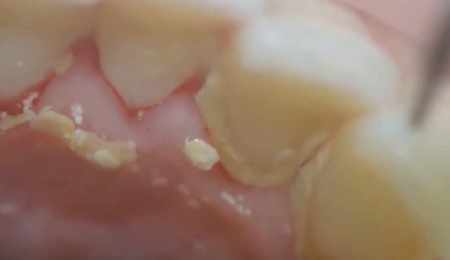“It’s no big deal!” – some people think. And they’re wrong! Plaque builds up not only on your teeth, but also on your gums and tongue, and can’t be removed by brushing, but builds up very quickly. And it won’t take long before you’re in trouble for your overall oral health. This article is for those who want to learn about effective plaque control.
Causes and Stages of Plaque Formation
Plaque is caused by many factors that are very different in nature, including:
- Deficiencies in oral hygiene (poor quality, lack of regularity)
- Smoking
- Consumption of tea, coffee, and soft foods
- Sugar and carbohydrates in the diet
- Use of certain medications
- bite problems
- gastrointestinal diseases
- endocrine disorders
It’s impossible to avoid plaque, so you need to know how to deal with it effectively.
So, it is important to know that a distinction is made between soft and hard plaque. Soft plaque is formed as a result of accumulation of food remains on the tooth surface, even in small children; hard plaque is the result of lack of timely action to remove soft plaque, which is a breeding ground for pathogenic microorganisms, with time as a result of their vital activity thickens and darkens.
Once established on the tooth surface, the bacteria begin to produce acids that can destroy the enamel. Within a few weeks, plaque mineralizes into tartar without satisfactory oral hygiene.
There are three stages in the formation of plaque:
Time after dental hygiene procedures (brushing, flossing, etc.) vs. plaque build-up on teeth
- After 4 hours: The beginning of bacterial proliferation
- 4-7 hours: tenfold increase in the number of microorganisms in the mouth, the appearance of a soft biofilm to attach them to the surface of the teeth
- 6-7 hours: fully formed plaque visible to the naked eye.
It is impossible to remove hard plaque at home, the only true solution is to seek professional help from a dentist.
The Consequences of Plaque Formation
It is also important to realize that dental plaque is not purely an aesthetic problem: if the inevitable soft plaque is not removed in time, people risk facing a number of unpleasant consequences. These consequences should include:
- Cavities. The acids released by microorganisms contribute to the destruction of enamel, as a result of which the tooth structure is easily penetrated by infections, leading to the development of cavities and then to periodontitis and pulpitis.
- Dental surgery complications. During tooth extraction or other oral surgery, plaque poses a risk of complications as a source of infection.
- Gingivitis and periodontitis. Plaque build-up can cause gum inflammation, loss of gum tissue, bleeding gums and can cause premature tooth loss.
- Halitosis. One of the consequences of plaque is bad breath, which can be a major barrier to social interaction.
How to Get Rid of Plaque
The removal of plaque on the teeth must be dealt with comprehensively and regularly, at home – daily, in the dental office – twice a year. Let’s look at the main points and differences between home and professional hygiene:
Home hygiene
Does not provide a complete cleaning of tartar accumulated in inaccessible areas, but ensures the maintenance of oral hygiene at home.
Basic requirements:
- Thorough brushing in the morning and evening
- Mandatory tongue cleaning with special brushes and scrapers
- Rinsing the mouth after each meal, alternatively using chewing gum
- Freshening of breath with mouthwash.
Important conditions are the correct choice of toothbrush (narrow head, thick soft bristles), brushing between the teeth, use of dental floss, toothbrushes and irrigators.
Professional hygiene
Performed by a dental hygienist, allows you to effectively remove deposits in hard-to-reach areas and persistent pigmented plaque.
The procedure includes:
- thorough removal of plaque + antibacterial effect
- Restoration of natural whiteness of teeth
- enamel polishing
- prevention of caries and periodontitis
As a result of the procedure teeth become whiter and smoother, the formation of plaque on the polished surface of the teeth is noticeably slower.
Removal of plaque at home is a necessary but temporary measure, the main cleaning process is possible only at the dental office. Professional dental hygiene is indicated before prosthetics and braces, before bleaching and re-mineralization, and for everyone who wants to have a beautiful smile and healthy teeth. Modern methods of professional teeth cleaning:
- ultrasonic cleaning
- mechanical cleaning
- Air-flow method (air-abrasive)
If you’ve never been to a dental hygienist, it’s definitely time for a professional cleaning! The hygienist will recommend a toothpaste and toothbrush and teach you how to brush your teeth properly.






